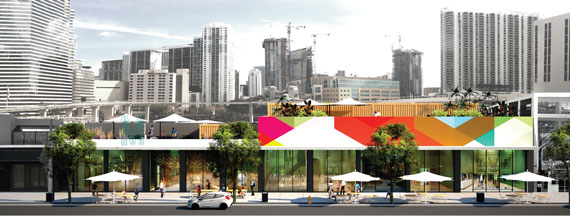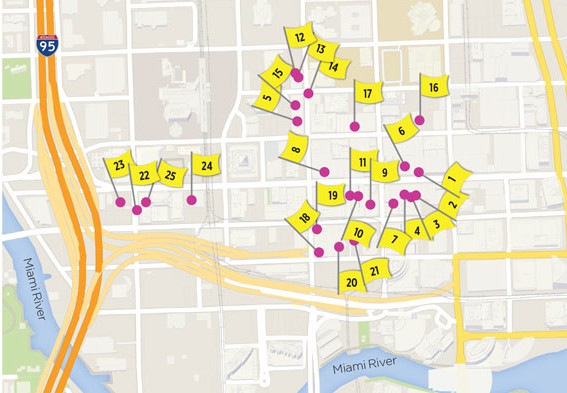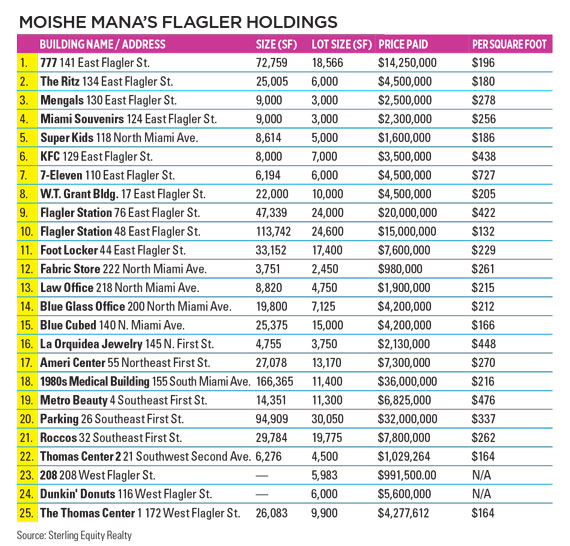Over the past five years, Moishe Mana has embarked on a spending spree in the downtown Miami and Wynwood neighborhoods. During the decades prior, Mana, who immigrated to the United States from Tel Aviv, built a moving-and-storage empire and transformed urban areas including Jersey City.
Since 2010, he’s been in Miami, assembling downtown what he calls the Flagler District and accumulating about 30 acres in Wynwood. He has targeted the same neighborhood that Tony Goldman, the now deceased founder of Goldman Properties, first started to develop in 2009.
“I figured I could pick up the pieces from here and continue what Tony started,” Mana told The Real Deal of his thinking during the recession. “I started buying with conviction. Everything was a mess here. Everyone thought I was crazy.”
Disagreeing with those who call Miami a suburb of New York, Mana said that he wants to create a cultural infrastructure for the community.
“Miami is still in its early stages and it needs people like me. New York has all the people in the world,” Mana said. “We are at the beginning of everything. It takes time to create the businesses, bring the businesses, curate what we want to bring here at the intersection of art and entertainment.”
Wynwood today reminds Mana of New York’s Meatpacking District in 1995 when he opened Milk Studios, a media company. The urban transformation he hopes to achieve in Wynwood and downtown will be a combination of retail, residential and cultural components — unlike the planned massive, mixed-use developments nearby, he said.
“We want to make it interesting and affordable,” Mana said. “The magic of South Beach is over and the movement is now toward downtown and the Brickell areas.”
Mana intends to continue to expand his Mana Wynwood complex, which he opened in 2010, as a concert, entertainment and art venue, so it will become a cultural destination for Latin America and the Caribbean, he said. The space today hosts events, a production village and his office.
Concerned that Wynwood’s small-scale businesses such as local art galleries will be pushed out due to rising rents and increased demand, Mana said, “We don’t need to make money from everything.”
In July, Mana acquired the former MacArthur Dairy site, west of Wynwood, for $8.5 million. The 5.32-acre site’s zoning allows for 150 units per acre; he is planning to use it as a logistics center.
In August, a Mana subsidiary, Mapton Holdings, along with Wynwood-based Berenblum Busch Architecture, announced plans to develop a Puerto Rican Community Center on Northwest Second Avenue in Wynwood through a land swap construction deal between Miami-Dade County and Mana. The county gave Mapton 60,560 square feet of land valued at $6.8 million. In exchange, Mapton will give the county 15,715 square feet of Wynwood land valued at $3 million.
The $7.37 million, three-story, 49,000-square-foot development will include artist studios, a café, community spaces, offices and parking. About $2.5 million of the facility’s cost will be paid for by a county bond, with the rest footed by Mana.
Mana and his team are working on a five- to 10-year internal timeline for developing Wynwood and the Flagler district downtown. One goal, according to Dylan Finger, the managing director of Mana Wynwood, is to make both areas affordable and cool enough for young, urban professionals.
“With the undertakings that we have, we recognize that a key component of that is really bringing in the right demographic and person to the neighborhood [who] can effectively make a change,” Finger said. “In Miami, we have these nice condo buildings that are beautiful. But they’re not affordable; they’re out of reach.”
Either Miami’s young professionals “have to share an apartment or live in Kendall or live at home or live far away from the urban core,” he said.
Mana has tapped young talent at the University of Miami and Florida International University in his efforts to plan development in both areas. In collaboration with the former, the Mana team is studying millennials to determine what they want, what they’re prepared to share and what makes them comfortable, Finger said.
“Once we come up with these ideas on how we can make it possible to bring youth and millennials into the downtown urban core, which really effects change, we’ve got to make it affordable enough and cool enough,” Finger said. This might mean creating micro apartments.
The Mana crew is also working with Florida International University on a Wynwood master plan and hosting a design studio this semester for students at Mana Wynwood. Each team in the class is responsible for planning a different piece of development. “At the end, we’ll have a scale model printed in 3-D of the outcome of the entire workshop. We’ll announce that at Art Basel,” Finger said.

Moishe Mana’s designs for the Flagler district include this vision for cafés along Southeast First Street.
For the Flagler district, Mana and members of his team have been working with the city of Miami to craft a master plan for future development and to create land-use entitlements.
Mana intends to do construction in phases. For now, he plans to renovate existing structures from the 1920s and later.
“I’m working with three, four, five different architects,” Mana said of his company’s development plans. “We need the different perspectives.
“Bernard Zyscovich has been great for us here in terms of creating the vision, working with the city, county,” Mana added.
“I don’t see it as competition. There’s plenty for many talents to come here and show us what we can do,” Mana said. “Do people reach out? All the time. I share with them my knowledge, my understanding. We need more of that.”
Mana has spent $198 million acquiring properties in downtown Miami, he said, noting that he does not have financial backers. “It’s very hard to get [bank financing] for properties not producing very much income,” he said.
Investors and business owners, however, are very much banking on Mana’s plans for the Flagler District. There Daniel Pena has recently redeveloped the Langford Hotel, which is scheduled to open this winter. The historic property, at 121 Southeast First Street, was severely deteriorated when Pena’s firm, Stambul, acquired it in 2013. Miami National Bank once occupied the structure, which was built in 1925.
Flagler Street and the surrounding area need more people like Pena, Mana declared. “Once you start something, people will join. I see it in the whole business community here,” Mana said. “I buy critical mass to create what I need to create. That’s why I went ahead and bought in Wynwood and the Flagler District.”
Pedestrian traffic and retail sales in the Flagler district are down and have been for years, Mana observed. “Some businesses are leaving, closing down.” He hopes to engineer a transformation process.
Mika Mattingly, a broker with Sterling Equity Realty who works to acquire parcels for Mana’s projects, said investors have previously viewed Miami’s urban core as a “dormant wasteland,” which has resulted in a sense of fatigue among local business owners. Once change starts to happen, “they will happily jump on the bandwagon,” said Mattingly, who has represented Mana in nearly all his acquisitions. “Mana is a beam of hope for them, yet the years of neglect give them just cause to be skeptics.”
Prices have tripled in the downtown area and Flagler since Mana first began assembling downtown parcels in January 2014, according to Mattingly. “The same investors who told me I was crazy for focusing on downtown are now blowing my phone up to see if there is any inventory left to purchase, even at inflated current prices,” she said.
Mattingly has spent the last 18 months sourcing off-market deals. Mana’s Flagler area assemblage is nearly completed, she said. “Most downtown property is family owned or in a trust with multiple owners and most had not changed hands in the last half century.”
Alex Zylberglait, an investment broker with commercial brokerage Marcus & Millichap, said property sales activity in the Flagler Street area began picking up in early 2014. “You’re seeing private money really willing to bet on what’s going on, which is very anticipatory,” Zylberglait said. “The opportunity really lies in purchasing these buildings that can be redeveloped — office, residential, hotels, things that lend themselves to urban living. That’s how we can justify the prices.”
National retailers and restaurants that have not historically been downtown want to have a presence, Zylberglait claimed. “Successful restaurants will find a way to stay there,” he said. “You will see a decent amount of turnover over the next few years. Some will flourish and some won’t.”
To the south, Brickell City Centre will be anchored by Saks and include a number of national retailers. To the northeast, in Overtown, Miami Worldcenter just broke ground and will be anchored by Bloomingdale’s and Macy’s. New transit options will also fuel the area’s success, Zylberglait said. All Aboard Florida is building its MiamiCentral station as a 9-acre mixed-use development.
Canadian investor Danny Lavy is also counting on Flagler Street’s revitalization. He has purchased multiple retail properties in the area this year, including 219 East Flagler Street, 226 East Flagler and retail and office condos at One Flagler. “It’s got so much charm and so much history,” Lavy said of the district. “I think he’s selling a dream,” Lavy said of Mana.
While Lavy hopes to eventually renovate his property, he said, “I don’t think so much is going to happen in the next five years.” For now, he will try to lease his properties.“I bought it for the long term.”
“It’s not that it needs change,” Brian Alonso, department store La Epoca’s co-owner, said of the Flagler district. “It’s just that the change is happening. We’re finally growing vertically; our downtown has residents.”
Alonso, whose downtown boutique department store just celebrated its 50th anniversary, serves as the co-chair of the Flagler Street Task Force, which is planning to launch a $13 million improvement project for the historic district. The goal is to make a half-mile stretch of Flagler Street more pedestrian friendly by expanding and straightening sidewalks and adding 150 trees and benches and bicycle racks. Such improvements will complement planned development around Flagler Street and will be oriented toward restaurants and “interesting retail” outlets, Alonso said.
Downtown was one of the earliest areas to be developed in Miami in the 1890s. During that time Henry Flagler, principal of Standard Oil, founded Florida East Coast Railway, which today owns All Aboard. Flagler is considered the father of Miami and Palm Beach.
Some might say Mana resembles a hip version of the founder of the very district he is trying to rejuvenate.


